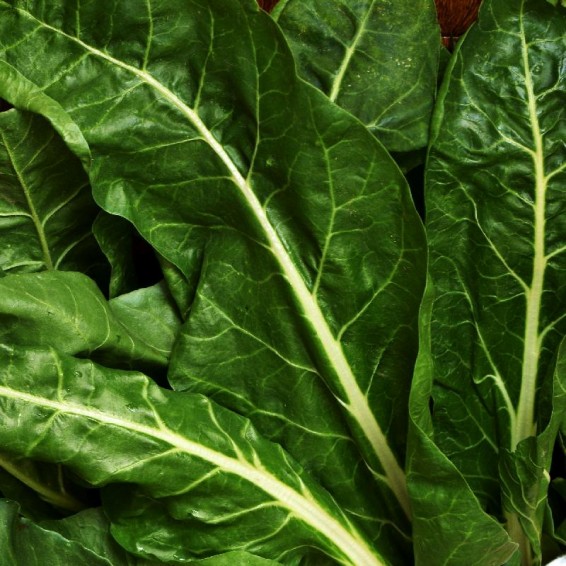Barese Swiss Chard Seeds
- HOW TO GROW
- FAST FACTS
- REVIEWS
HOW TO GROW
Sowing: Direct sow Swiss chard about a week after the last spring frost, planting it 1/2" deep in compost-enriched soil in full sun. For harvesting the entire plant, space the plants 4-5" apart; for continual harvesting of the outer stalks, space the plants 8-10" apart for larger growth. For a continuous summer crop, plant more Swiss chard every two weeks. Germination should occur in about a week. Swiss chard can survive light frosts, and can be planted as a fall crop.
Growing: Keep the soil evenly moist and weed free with a layer of mulch. Moisture is especially crucial to the seedlings in the first stages of their growth.
Harvesting: We'll tell you when you should be harvesting your Swiss chard seeds. We'll tell you when you should be harvesting your Swiss chard seeds. Individual leaves can be harvested for greens as soon as they reach a height of 6-8". The whole plant can be cut at the surface of the soil, but to ensure continued growth and another harvest, leave an an inch of stem. Outer stalks can also be harvested individually, leaving the heart to grow. The Barese variety was developed especially for baby leaves, but they are also excellent when allowed to fully mature.
Seed Saving: Since Swiss chard is wind pollinated, be sure to separate them from other varieties of chard and beet by at least two miles to preserve genetic purity. Swiss chard plants must weather the winter in order to produce seed; in warmer climates, simply mulch the plants. In cooler climates, dig up the roots and store them in sand, without the roots touching, in a cool and humid location; plant them in early spring. In the spring, the plants will go to seed; wait until the seed heads are fully grown and dry before removing them. The Barese Swiss Chard seeds will readily come off the stems after they are completely dry. Store Barese Swiss Chard seeds in a cool, dry place for up to five years.
FAST FACTS
Latin Name: Beta vulgaris cicla
Type: Open Pollinated, Cool Season
USDA Zones: 3, 4, 5, 6, 7, 8, 9, 10, 11, 12
Seeds per Ounce: 1,500
Planting Method: Direct Sow
Sunlight: Full Sun
Height: 10 Inches
Color: Green
Great Price, Great Shipping
At this time when it is very difficult to find seeds due to coronavirus pandemic Everwilde Farms show great variety of seeds in different bag sizes
They shipped my two bags of swiss chard seeds very promptly so that I can share them with our children to be planted several times this year
Thank you Everwilde Farms!
DESCRIPTION
HOW TO GROW
Sowing: Direct sow Swiss chard about a week after the last spring frost, planting it 1/2" deep in compost-enriched soil in full sun. For harvesting the entire plant, space the plants 4-5" apart; for continual harvesting of the outer stalks, space the plants 8-10" apart for larger growth. For a continuous summer crop, plant more Swiss chard every two weeks. Germination should occur in about a week. Swiss chard can survive light frosts, and can be planted as a fall crop.
Growing: Keep the soil evenly moist and weed free with a layer of mulch. Moisture is especially crucial to the seedlings in the first stages of their growth.
Harvesting: We'll tell you when you should be harvesting your Swiss chard seeds. We'll tell you when you should be harvesting your Swiss chard seeds. Individual leaves can be harvested for greens as soon as they reach a height of 6-8". The whole plant can be cut at the surface of the soil, but to ensure continued growth and another harvest, leave an an inch of stem. Outer stalks can also be harvested individually, leaving the heart to grow. The Barese variety was developed especially for baby leaves, but they are also excellent when allowed to fully mature.
Seed Saving: Since Swiss chard is wind pollinated, be sure to separate them from other varieties of chard and beet by at least two miles to preserve genetic purity. Swiss chard plants must weather the winter in order to produce seed; in warmer climates, simply mulch the plants. In cooler climates, dig up the roots and store them in sand, without the roots touching, in a cool and humid location; plant them in early spring. In the spring, the plants will go to seed; wait until the seed heads are fully grown and dry before removing them. The Barese Swiss Chard seeds will readily come off the stems after they are completely dry. Store Barese Swiss Chard seeds in a cool, dry place for up to five years.
FAST FACTS
Latin Name: Beta vulgaris cicla
Type: Open Pollinated, Cool Season
USDA Zones: 3, 4, 5, 6, 7, 8, 9, 10, 11, 12
Seeds per Ounce: 1,500
Planting Method: Direct Sow
Sunlight: Full Sun
Height: 10 Inches
Color: Green
Reviews
Review
Great Price, Great Shipping
At this time when it is very difficult to find seeds due to coronavirus pandemic Everwilde Farms show great variety of seeds in different bag sizes
They shipped my two bags of swiss chard seeds very promptly so that I can share them with our children to be planted several times this year
Thank you Everwilde Farms!





